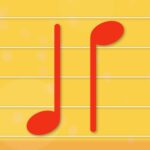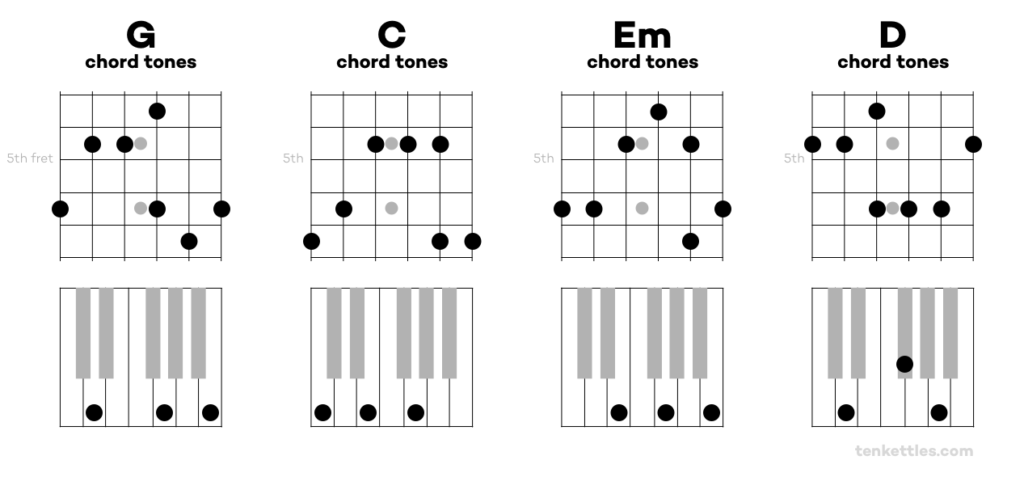Build Your Skills
Learn music theory Train your ears Track your tempoRead Now
Get the Newsletter
Categories
- | BeatMirror (10)
- | HearEQ (11)
- | Waay (22)
- | WaayFinder (1)
- Audio (16)
- For musicians (34)
- Guitar (2)
- Music theory (15)
- News (42)
- Startup stories (2)
- Tutorial (4)
Keep in Touch
About Ten Kettles
We love music, we love learning, and we love building brand new things. We are Ten Kettles.
Read more >-
September 30, 2022
Build Improvisation Skills with This Jamalong
Writing beautiful melodies—melodies that you love—takes practice. One way I really like to practice is by improvising with constraints. That may seem counterintuitive at first. Why constraints? Shouldn’t our songwriting feel unconstrained?
The Jamalong (“jam along”) exercise presented in this article is constrained for three very good reasons.
Why Constraints?
First, because your writing is already constrained. By habit and skill. Especially when you reach the point that your “improvised” melodies start to sound a bit too familiar, you can use other constraints—like the ones in this exercise—to stimulate new playing and writing patterns. So by constraining one thing, you can “unconstrain” another!
Second, a melody has a relationship with the supporting chord progression. As you play a note, it interplays with the notes in the chord underneath. An E played over an A minor chord will sound one way; an E played over a D major chord will sound very different. Our exercise explores this relationship and helps you develop a feel for it.
Third, these are exercises. Though you may come up with some great song ideas as you do them, that’s just a happy byproduct. What you’re doing is developing skills to support your writing and improvisation. Just like you practice a warm-up pattern on the fretboard, or maybe a scale or two on the piano, these are skill-training exercises too.
Part 1: Playing Chord Tones
There are two steps to this exercise. First, play along to the Jamalong progression below using ONLY chord tones (i.e., the notes in each chord). That is, when the G major chord plays, just play any G, B, and/or D. If you’re still learning the notes on your guitar or piano, I’ve made a few images below that should tell you all you need to know. (You may also want to check out Waay!)
The goal here is to make your playing sound as musical—as authentic—as you can, despite the constraints. Don’t just mindlessly play through the three notes of each chord. Instead, work with the feel, the rhythm, the soul of it. Enjoy it. You don’t need to hit all three chord tones every bar, but aim to usually hit at least two. Here’s what that might sound like:
Once you can get through the whole Jamalong (i.e., four repetitions) without any mistakes, try it again. Play chord tones along with the recording, and once you’ve either a) played it through twice in a row without any mistakes, or b) spent more than 5 minutes on it and don’t feel like you’re making progress anymore for now, then move on to Part 2.
Part 2: Unconstrained
OK, now just play. Be thoughtful of where those chord tones are, but feel free to play any other notes you like as well. The goal here is to play something you like. Exercise your musical judgment and enjoy yourself. Here’s an example of a melody part I came up with that I really like:
After you’ve played one or two solid melodies along with the progression, either return to Part 1 or give yourself a pat on the back and call it a day. You did good work!
The Jamalong Progression
Here’s the Jamalong you’ll be using for the two exercises above. It’s in the key of G major, the progression has four chords, and it’s repeated four times. There’s also a four-beat count-in. If you’re still learning chord tones or the note names on your instrument, there are chord tone diagrams below for guitar and piano too (tap image for large version).
GCEmDGCEmDGCEmDGCEmD
Conclusion
Sometimes the best way to practice songwriting is to just write songs! But other times we can feel like our skills aren’t quite up to the task, or that our inspiration isn’t there today. That can be a great time to practice some useful songwriting exercises like this one.
But that’s not all: it’s important to have a strong base of musical understanding too. You can build that understanding, and confidence, with Waay. Learn about keys, scales, chords, progressions and how they all fit together in a way that sounds good to you. Now with special skill retention tools so that the knowledge is there when you need it.
Get Waay today for iPhone or iPad.




Comments